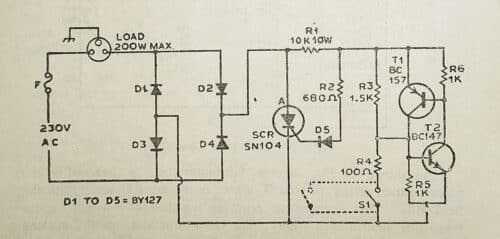Electronics: A genteel version of Electricity!
I always wondered how to explain to a layman the difference between ‘Electricity’ and ‘Electronics’. Well, I tried to explain to them on a lighter note that ‘Electricity’ is a wild tiger and ‘Electronics’ is a tamed pet!
Simply press the button and the electrical power is fed to the load. That is ‘Electrical operation’.
Electronics is a myriad manifestation of Electrical power. In ‘Electronic operation’, you can alter the voltage, limit the current, change the frequency, modify the waveform, modulate the pulse width, select a mode of operation, invert the power supply, time the operation, and so on! Electronics use Electrical power in a ‘tailor-made’ fashion. Electronics, thus, is a ‘decisionmaker’.
Here I would like to share an experimental circuit I assembled as a hobby project back in 1982 to try to explain the difference between Electricity and Electronics. It is based on a schematic I came across in a book titled ‘ Practical SCR and TRIAC projects’ by M C Sharma (BPB Publishers). The project is still working.

The aim of the article is just to explain the difference mentioned above hence the technicalities are not discussed. The output in the project is an incandescent filament bulb. There are two ‘push-to-on’ switches A and B. As per the schematic, when switch A is pushed, the bulb is switched on ‘electrically’. When switch B is pushed, the bulb is switched on ‘electronically’. From just a physical observation we see that the bulb glows in both cases. However, interestingly, here lies the difference between electrical operation and electronic operation.

When switch A is pushed, the electrical power suddenly rushes in randomly from anywhere in the half cycle of the sine wave and worse if it is in the middle of the half sine wave cycle. This causes undesirable and uncontrolled effects like high-frequency spikes called ‘radio frequency interference’ in the nearby environment. The same thing might happen when switch A is released to switch off the power abruptly anywhere in the half cycle of the sine wave. The situation is most annoying when there is fast and repeated switching. This is ungraceful and ‘wild’ electrical switching.

When switch B is pushed, the SCR conducts only when the triggering voltage is under approximately 10 volts at the rising of the DC pulse very close to zero crossing. Once the voltage rises above 10 volts, the transistor pair conducts and latches and the SCR cannot be triggered but has to wait till the next DC pulse begins. So the bulb is switched on only at the beginning of the rising DC pulse very close to zero crossing where radio frequency generation is negligibly low. The same thing happens when switch B is released to switch off the power. The SCR continues to conduct till the next zero crossing even if switch B is released anytime and there is no radio frequency interference at all during switch-off operation. This is graceful and ‘tamed’ electronic switching!
Electronics is thus a genteel version of Electricity!








